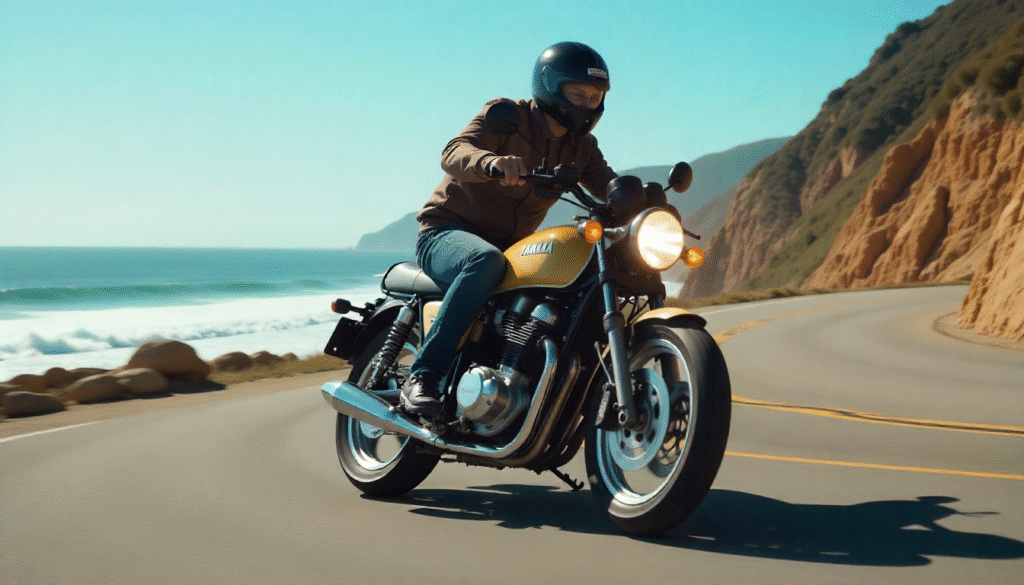What Is Escapamento RD?
The phrase “escapamento RD” brings together two key elements of motorcycle culture. “Escapamento” is Portuguese for exhaust system, while “RD” refers to Yamaha’s legendary RD motorcycle line. Together, the term describes the exhaust systems built for Yamaha’s two-stroke RD bikes—machines celebrated for their speed, agility, and unmistakable exhaust sound.
Models such as the RD125, RD250, RD350, and RD400 became icons, especially in Brazil and Portugal. Their unique combination of performance and sound turned the escapamento RD into more than a bike part—it became a cultural symbol of freedom, individuality, and power.
Origins of the Yamaha RD Series
Yamaha introduced the RD series in the 1970s, with RD standing for Race Developed. These motorcycles delivered racing-level performance to everyday riders through lightweight frames and aggressive two-stroke engines. Unlike heavier four-stroke engines, two-strokes were simple, fast, and easy to modify—making them an instant hit with young riders.
The exhaust system quickly became the heart of these modifications. In Brazil, it played a central role in the rise of street racing culture, where enthusiasts called the escapamento RD “the soul of the bike.”
Role of Escapamento RD in Two-Stroke Engines
On an RD motorcycle, the exhaust is more than just a pipe. Its expansion chamber design is vital to how the engine runs, sounds, and stays cool.
| Function | Role in Engine | Benefit to Rider |
|---|---|---|
| Gas Expulsion | Clears burnt gases | Keeps engine breathing smoothly |
| Airflow Control | Balances intake and exhaust | Boosts acceleration and power delivery |
| Acoustic Signature | Shapes exhaust resonance | Produces the famous RD two-stroke sound |
| Heat Management | Reduces engine temperature | Increases durability and performance |
This design is what gives RD motorcycles their iconic high-pitched scream and sharp throttle response.
Stock vs. Aftermarket Escapamento RD
Factory exhausts were reliable and built for general use, but many riders wanted more power and a louder, sharper sound. This led to a thriving aftermarket scene, especially in Brazil during the 1980s and 1990s. Custom-made pipes, often hand-welded, boosted horsepower and gave bikes a unique identity.
Even today, aftermarket escapamentos remain popular, offering riders both performance gains and a personal touch.
The Sound – A Signature of the RD
The sound of a Yamaha RD with a tuned exhaust is unforgettable. At idle, it crackles sharply; at high revs, it howls with intensity. Riders describe it as a “voice of freedom” that could be heard from blocks away.
For many, tuning the sound of their escapamento was just as important as performance, making it one of the most defining elements of RD culture.
Tuning and Performance
Adjusting the length and width of an escapamento’s chamber changes how the bike performs. Wider, shorter chambers favor high speeds, while longer, narrower pipes deliver stronger mid-range torque. Riders often combine these adjustments with carburetor tuning for maximum results.
Brazilian workshops became famous for hand-building exhausts tailored to drag racing or city riding, blending traditional skill with modern techniques.
Cultural Impact in Brazil and Beyond
In Brazil, the RD was more than transport—it was a symbol of independence. Local garages became gathering spots where riders shared tuning secrets, built custom exhausts, and raced in the streets. Portugal, Japan, and other countries also embraced the RD legacy, and today, online communities keep the tradition alive through forums, videos, and restoration projects.
Common Issues & Maintenance
Two-stroke engines leave heavy carbon deposits, making regular cleaning essential. Common problems include:
- Carbon buildup, requiring decarbonizing
- Rust in humid climates
- Silencer material wearing out
- Weld or flange leaks
Proper care ensures the escapamento RD keeps its sound and performance intact.
Modern-Day Escapamento RD
Although Yamaha no longer makes RD motorcycles, the exhaust systems remain highly valued. Collectors and restorers search for original or replica parts, while workshops create high-quality reproductions with modern tools. In digital spaces, RD bikes live on in racing games, sound libraries, and simulations, introducing the iconic exhaust note to new generations.
Why Escapamento RD Still Matters in 2025
- Keeps two-stroke motorcycle heritage alive
- Produces a sound unmatched by modern bikes
- Inspires creativity in tuning and engineering
- Connects past riders with today’s restoration culture
- Represents a global community of passionate enthusiasts
Challenges and Regulations
Not everyone is a fan. The loud sound often sparks noise complaints, and two-stroke engines release more emissions than four-strokes. Some cities restrict their use on public roads. Riders today must balance passion with responsibility, ensuring they keep the culture alive without causing unnecessary issues.
The Future of Escapamento RD
Looking ahead, the RD legacy will likely continue in three ways:
- Restoration – Original and replica exhausts for collectors.
- Retro Influence – Modern bikes and even electrics borrowing RD styling.
- Digital Preservation – Simulations, VR, and gaming keeping the sound alive.
Final Thoughts
The escapamento RD is more than steel and welds—it’s a symbol of freedom, rebellion, and passion. It shaped the identity of Yamaha’s two-stroke era and continues to inspire bikers and collectors around the world. For anyone who has heard its piercing scream, the memory stays forever.
FAQs
1. What is escapamento RD?
It’s the exhaust system used in Yamaha’s RD two-stroke motorcycles.
2. Why is it special?
Because it improves performance, produces a unique sound, and carries deep cultural meaning.
3. Can I still buy one?
Yes—through vintage sellers, aftermarket builders, and restoration shops.
4. Why does it sound different?
The expansion chamber design creates the sharp, high-pitched RD scream.
5. How do I maintain it?
Regularly clean carbon, protect against rust, check welds, and repack the silencer.


